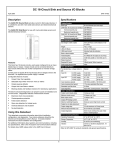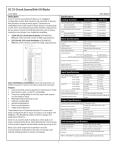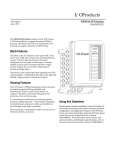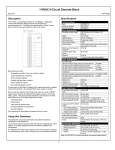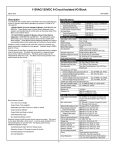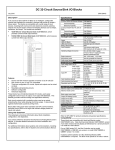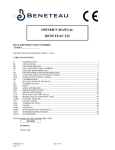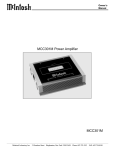Download Genius 115VAC 16-Ckt Input Block datasheet, GFK
Transcript
115VAC 16-Circuit Discrete Input Block June 2002 GFK-0037F Description _____________________________________ Specifications _________________________________ The 115VAC Discrete Input Block (IC66*BBD110) is an intelligent, configurable module that provides an interface to 115VAC discrete input sensors. The block has sixteen 115VAC circuits - two banks of eight circuits each. Catalog Numbers Typical inputs to this block are contact closures from switches, pushbuttons, or limit switches. The block can be used with both 2wire and 3-wire proximity switch inputs. Control power for the block comes from the power line that supplies the inputs. No separate block power supply is needed. Block type 16 circuits, inputs only Block IC66*BBD110 Electronics Assembly IC66*EBD110 Terminal Assembly IC66*TBD110 Block Specifications Size (height x width x depth) 115V 50/60 Hz Input 8.83” (22.44cm) x 3.34” (8.48cm) x 3.91” (9.93cm) Weight 4 lbs. (1.8 kg) LEDs (I/O Block) Unit OK, I/O Enabled LEDs (each circuit) Reflect state of input (logic side) Input to ground or serial bus Isolation 1500V Heat Dissipation 28 Watts maximum with 16 inputs on at full current Operating voltage (single source) 93-132VAC Frequency 47-63 Hz Required power (block only) 80mA max. block current plus 200mA max. input circuit current Terminal board rating (input or feed-through current) 5.0 Amps Power supply dropout time 1 cycle (16.7ms at 60Hz, 20ms at 50Hz) Features Input Specifications Block features include: Input off state, input on state Programmable threshold (25% to 85%) Input impedance (typical) 11.6K Ohms Input open wire Programmable threshold (25% to 85%) Input shorted wire Fixed 10%-90% thresholds Input processing time (typ) 1ms (plus selectable filter time) Selectable thresholds Advanced diagnostics Software Configurable Features The 16 Circuit 115 VAC Input Block provides configurable detection of Open Wire and Shorted Wire faults. Selectable thresholds extend the use of Open Wire and/or Shorted Wire diagnostics to circuits with many types of input devices and sensors. There are separate On/Off thresholds for each group of eight inputs. On/Off thresholds are configurable from 25% to 85% of the incoming line voltage, allowing the use of a wide variety of input sensors. Selectable input filter times 10 to 100ms in 10ms increments Input diagnostics Open Wire, Short Circuit Environmental Specifications Optional Open Wire detection can be selected for individual inputs. The Open/Off threshold can also be configured at 25% to 85% of the incoming line voltage. Separate Open/Off thresholds can be selected for each group of eight inputs. Optional Short Circuit detection at 10% and 90% of the incoming line voltage can also be selected for individual inputs. Operating temperature 0° C to +60° C (+32° to +140° F) Storage temperature -40° to +100° C (-40° to +212° F) Humidity 5% to 95% (non-condensing) Vibration 5-10 Hz 0.2” (5.08mm) displacement, 10-200 Hz at 1G Refer to GFK-0867 for product standards and general specifications. Using this Datasheet __________________________ For most applications, the default thresholds and recommended resistor values are not changed. This datasheet summarizes information about block installation, configuration, and diagnostics. Fault reporting can also be enabled or disabled circuit-by circuit. Your primary reference should be the Discrete and Analog Blocks User’s Manual. It includes detailed instructions for block installation and configuration. For additional information about systems and communications, including bus specifications, refer to the I/O System and Communications Manual. 1 115VAC 16-Circuit Discrete Input Block June 2002 GFK-0037F Compatibility __________________________________ If the block is at either end of the bus, connect a terminating resistor of the appropriate type (see the System and Communications User’s Manual for details) across its Serial 1 and Serial 2 terminals. This block is fully compatible with Hand-held Monitor model IC66*HHM501 only. Start of Bus Installation Instructions __________________________ End of Bus Terminating Resistor Terminating Resistor Carefully inspect all shipping containers for damage. If any equipment is damaged, notify the delivery service immediately. Save the damaged shipping container for inspection by the delivery service. After unpacking the equipment, record all serial numbers. Save the shipping containers and packing material in case it is necessary to transport or ship any part of the system. Serial 1 Serial 2 Shield In Shield Out Serial 1 Serial 2 Shield In Shield Out Block Mounting Genius I/O blocks are considered "open equipment" and therefore must be installed within a protective enclosure. They should be located in an area that is clean and free of airborne contaminants. There should be adequate cooling airflow. Field Wiring Terminals 5 to 32 are for field devices. They take a single wire up to AWG #14 (avg 2.1mm2 in cross-section). Minimum recommended size is AWG #20 (avg .54mm2 in cross-section). The block can be mounted right side up, or upside down. Leave at least 2 inches of space between blocks. Mount the block by drilling two screw or bolt holes for 8-32 hardware. Position the block so that the notches in the upper and lower flanges line up with the mounting holes. Mount the block using 8-32 screws. Use star washers to provide ground integrity. 5 6 7 8 9 10 11 12 13 14 15 16 17 18 19 20 21 22 23 24 25 26 27 28 29 30 31 32 Grounding The block’s mounting screws must not be used as the only means of grounding the block. Connect the green ground screw on the block to a reliable ground system using a short wire lead, minimum size AWG #12 (avg 3.3mm2 in cross-section). H Warning 115 VAC If mounting screws do not make good ground connection and the ground screw is not connected to a reliable ground, the block is not grounded. Electrical shock hazard exists. Death or personal injury may result. ~ N Block Wiring ____________________________________ Do not overtorque the terminal screws. Recommended torque for all terminals is 6 in/lb (.678 N/M). Serial Bus Wiring H H H H H H H H H H IN1 IN2 IN3 IN4 IN5 IN6 IN7 IN8 IN9 IN10 IN11 IN12 IN13 IN14 IN15 IN16 N N Run one signal wire for each device. Returns can be made to one or more of the H terminals; all H terminals are internally bussed, as are the N terminals. Extra power terminals are for convenience. Depending on layout and current loads, hot connections can be bussed together and made by one wire back to the block or power source. Neutral connections can also be bussed and made with one wire. Terminals 1 to 4 are for the serial bus. These terminals accept one AWG #12 wire (avg 3.3mm2 cross-section) or two AWG #14 wires (each avg 2.1mm2 in cross-section). The minimum recommended wire size is AWG #22 (avg .36mm2 in cross-section). Terminals 1 4 can also accommodate spade or ring terminals up to 0.27 inch (6.85mm) wide with a minimum opening for a #6 screw, and up to 0.20 inch (5.1mm) depth from the screw center to the back barrier. Be sure unshielded wire ends are not longer than 2 inches (5 cm). Power Source Wiring Connect the hot side of a 115 VAC source to an H terminal and the neutral to an N terminal. Using one of the cable types recommended in the System and Communications User’s Manual, connect the serial bus to terminals 1- 4. The power supply should not be fused higher than 5A. Caution 1 SERIAL 1 2 SERIAL 2 3 SHIELD IN 4 SHIELD OUT Do not daisy-chain the power bus to other blocks or devices through the extra H and N terminals. These terminals are for wiring convenience only; using them as power distribution points may result in damage to the block. Caution Make all block power connection to the same 120 VAC phase. Other blocks can use different phases. 2 115VAC 16-Circuit Discrete Input Block June 2002 GFK-0037F Power Disconnects Removing an Electronics Assembly _______________ Since block power is the same as circuit power, it is important to wire block power disconnects so that block power and input power will be removed at the same time. AC BLOCK NO YES The block’s Electronics Assembly can be replaced with a compatible model without removing field wiring or reconfiguring the block. Electronics Assembly H ~ Retaining Screws (Qty. 2) LOAD N Caution If I/O circuit power is not removed at the same time as block power, the block may power up when multiple inputs are activated, even though one leg of power has been removed from the block. Terminal Assembly Connector Pins If you want to disable the block without removing power from input devices, use a Block Puller to unplug the Electronics Assembly. Do not disconnect H or N to remove power. Wiring for Shorted Wire Detection If a circuit will use the configurable Shorted Wire detection feature, it may be necessary to install a resistor in series with the input device. For the default thresholds and a dry contact sensor, use a 3.9K ohm resistor. If the thresholds are changed, the resistor value must be selected as described in the Discrete and Analog Blocks User’s Manual. For some solid state sensors, additional external resistance may not be required. Consult the sensor manufacturer’s specifications. H 1. Unscrew the retaining screws at the top and bottom of the block. 2. Using a Block Puller (IC660BLM507), engage the tabs in the first vent slots. Move the tool to the center of the block and squeeze the handle. 3. Pull the Electronics Assembly upward. Warning If power is applied to the field terminals, power is also exposed on the connector pins at the base of the Terminal Assembly, and electrical shock hazard exists. Do not touch the connector pins! Death or injury may result. Rs ~ IN Inserting an Electronics Assembly N 1. Wiring for Open Wire Detection Caution If a circuit will use the configurable Open Wire detection feature, it may be necessary to install a resistor across the terminals of the input device. For dry contact sensors, the default thresholds are not changed and a 22K ohm resistor can be used. If the thresholds are changed, a resistor must be selected as described in the Discrete and Analog Blocks User’s Manual. For some solid state sensors, additional external resistance may not be required. Consult the sensor manufacturer’s specifications. Do not exert excessive force; it may damage the block. 2. If unusual resistance is met, remove the Electronics Assembly. If power is applied to the block, DO NOT TOUCH THE CONNECTOR PINS! Inspect the Terminal Assembly, connector receptacle, and connector edge board (on the Electronics Assembly). Be sure the keying matches. Remove any obstacles and reinsert the Electronics Assembly. Pay close attention to the alignment of the guide pins. 3. Secure the Electronics Assembly with the screws on the top and bottom of the Terminal Assembly. H Rp IN ~ N Open Wire and Shorted Wire diagnostics can be selected for the same input. The input circuit must then include both a series resistor and a parallel resistor to detect Open/Short conditions from a dry contact sensor. If the block’s default thresholds will be used, use the resistor values given above. H Rs IN Rp Align the Electronics Assembly in the guides and push down firmly. ~ N 3 115VAC 16-Circuit Discrete Input Block June 2002 GFK-0037F Block Operation ________________________________ Diagnostics __________________________________ Each circuit has its own LED that indicates the presence of On/Off threshold voltage. Open Wire and Shorted Wire diagnostics can be enabled separately or together. Each requires the addition of a resistor at the input device as shown previously. The Discrete and Analog I/O Blocks User’s Manual explains how to configure these diagnostics, and how to select the correct resistor for the application. H Vsource Input Device ~ Voltage Sensing Circuits 115 VAC Vin N Field Connections Open Wire: indicates an open wire from a sensor to the input terminals on a tri-state input. If this fault occurs, the block sets the input state to 0 in the CPU. Internal +5V 47K Shorted Wire: indicates a shorted wire to H or N. The block sets the CPU’s input state to 1 if the fault is short high or 0 if the fault is short low. Processor 11.6K Terminal Assembly Caution A short between In and N may result in high fault currents when the input switch is closed. This may blow the line fuse or cause overheating of series resistor Rs. Electronics Assembly Configuration ________________________________ The block’s input circuitry is resistive. The resistive load is sufficient to activate most 2-wire proximity switch devices. Input resistance is 11.6K Ohms, which provides a preload current of 9.9 mA at 115 volts. First, the block must be configured with a Hand-held Monitor to: LEDs _______________________________________ I/O Enabled Note: If a block is configured offline, it must be properly grounded and have a 75 Ohm resistor installed across its Serial 1 and Serial 2 terminals. See the Discrete and Analog I/O Blocks User’s Manual for instructions. Meaning ON ON Block functioning, CPU communicating ON OFF Block functioning Feature No CPU communications for 3 bus scans ON Blinking Block functioning, Circuit forced Blinking ON Circuit fault, CPU communicating Blinking OFF OFF Don’t Care Enter its Reference Number (required only for IC600 and IC550 series PLCs only). The rest of the features can be configured either using a Hand-held Monitor, or by sending a Write Configuration datagram to the block from the host. The Unit OK and I/O Enabled LED’s show the operating status of the block. Unit OK Enter its Device Number (serial bus address). Circuit or Block Factory Setting Selections Device Number Block null 0 to 31 (a number must be selected) Reference Address Block none Depends on host CPU type No CPU communications for 3 bus scans No block power, or block faulty Baud Rate Block 153.6 std 153.6 std, 153.6 ext, 76.8, 38.4 Kbd Input Filter Time 8* 10ms 10 to 100ms Open/Off Threshold 8* 25% 25-85% On/Off Threshold 8* 50% 25-85% Circuit fault Alternate Blinking Circuit fault, Circuit forced Synchronous Blinking No CPU communications - block number conflict Circuit LEDs indicate the presence of On/Off threshold voltage. Short Detect Circuit no yes, no Open Detect Circuit no yes, no Report Faults Circuit yes yes, no Configuration Protection Block disabled enabled, disabled * Set up separately for each bank of circuits (1 - 8 and 9 - 16) 4










